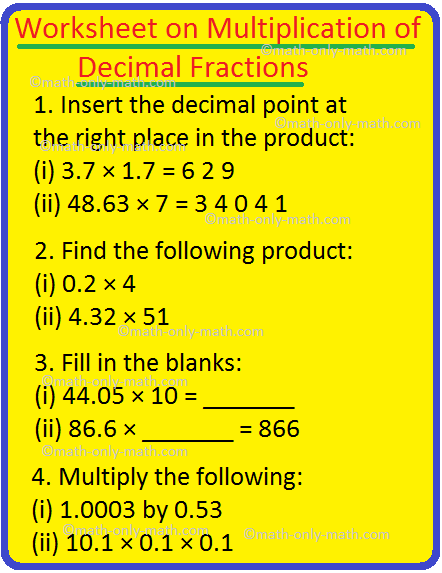Subscribe to our ▶️ YouTube channel 🔴 for the latest videos, updates, and tips.
Worksheet on Multiplication of Decimal Fractions
We will practice the questions given in the worksheet on multiplication of decimal fractions. While multiplying the decimal numbers ignore the decimal point and perform the multiplication as usual and then put the decimal point in the product to get as many decimal places in the product as there are in the multiplicant.
1. Insert the decimal point at the right place in the product:
(i) 3.7 × 1.7 = 6 2 9
(ii) 48.63 × 7 = 3 4 0 4 1
(iii) 5.05 × 1.2 = 6 0 6 0
(iv) 0.42 × 1.5 = 6 3 0
2. Find the following product:
(i) 0.2 × 4
(ii) 4.32 × 51
(iii) 2.007 × 36
(iv) 19.35 × 10000
(v) 89.015 × 10
(vi) 4.34 × 100
(vii) 3.125 × 86
(viii) 8.7 × 100
3. Fill in the blanks:
(i) 26.82 × 0 = _______
(ii) 3.006 × 1 = _______
(iii) 44.05 × 10 = _______
(iv) 86.247 × 100 = _______
(v) 86.6 × _______ = 866
(vi) 98.23 × _______ = 982.3
(viii) 4.812 × ______ = 4.812
(viii) 61.18 × ______ = 0
(ix) ______ × 4.985 = 4.985
(x) ______ × 61.6 = 0
(xi) 4.12 × 13.9 = 13.9 × ______
(xii) ______ × 7.83 = 7.83 × 1.92
(xiii) ______ × (7.9 × 1.4) = 2.9 × 7.9 × 1.4
4. Multiply 8.932 by 9. Write down the product orally when 8.932 is multiplied by
(i) 90
(ii) 900
(iii) 0.9
(iv) 0.09
5. Multiply the following:
(i) 1.0003 by 0.53
(ii) 10.1 × 0.1 × 0.1
(iii) 0.235 × 0.48
(iv) 0.52 × 0.07 × 4.3 × 0.02
(v) 51.8 × 0
(vi) 0.009 × 2.12
6. Find the product of the given decimal numbers:
(i) 21.3 and 7
(ii) 16.85 and 12
(iii) 0.4 and 0.56
(iv) 120.6 and 4.3
(v) 7.99 and 20
(vi) 12.45 and 0.6
(vii) 8.4 and 3.6
(viii) 40.08 and 0.6
7. Word problems on multiplication of decimals:
(i) A cyclist covers 15.75 km in one hour. How much distance will be cover in 8 hours?
(ii) 1 kg of milk has 0.352 kg of fat. How much fat is there in 20.5 kg of milk?
(iii) If a box of chocolates weighs 1.46 kg, find the weight of 5 boxes of chocolates.
(iv) A generator consumes 1.25 litre of diesel in one hour. How much diesel is required to run the generator for 8 hours?
(v) A litre of milk costs $ 7.25. What will be cost of 100 litre of milk?
(vi) John gets $ 3.75 and Sam gets $ 4.25 every day as pocket money in 7 days, how much more money does Sam get than John?
Answers for the worksheet on multiplication of decimal fractions are given below.
Answers:
1. (i) 6.29
(ii) 340.41
(iii) 6.060
(iv) 0.630
2. (i) 0.8
(ii) 220.32
(iii) 72.252
(iv) 193500
(v) 890.15
(vi) 434
(vii) 268.75
(viii) 870
3. (i) 0
(ii) 3.006
(iii) 440.5
(iv) 8624.7
(v) 10
(vi) 10
(vii) 1
(viii) 0
(ix) 1
(x) 0
(xi) 4.12
(xii) 1.92
(xiii) 2.9
4. (i) 803.88
(ii) 8038.8
(iii) 8.0388
(iv) 0.80388
5. (i) 0.530159
(ii) 0.101
(iii) 0.1128
(iv) 0.0031304
(v) 0
(vi) 0.01908
6. (i) 149.1
(ii) 202.2
(iii) 0.224
(iv) 518.58
(v) 159.8
(vi) 7.47
(vii) 30.24
(viii) 24.048
7. (i) 126 km
(ii) 7.216 kg
(iii) 7.3 kg
(iv) 10 litre
(v) $ 725
(vi) Sam gets $ 3.50 more than John
5th Grade Math Problems
5th Grade Math Worksheets
From Worksheet on Multiplication of Decimal Fractions to HOME PAGE
Didn't find what you were looking for? Or want to know more information about Math Only Math. Use this Google Search to find what you need.



New! Comments
Have your say about what you just read! Leave me a comment in the box below. Ask a Question or Answer a Question.